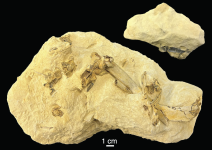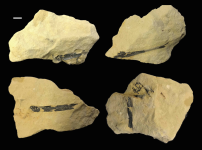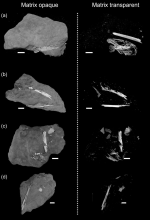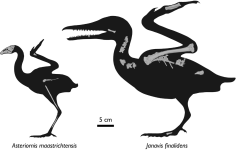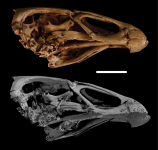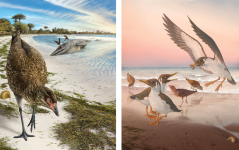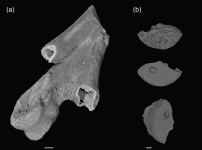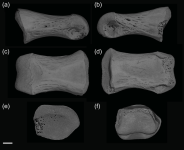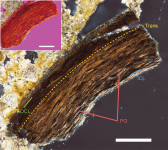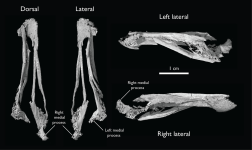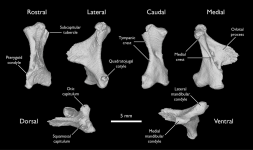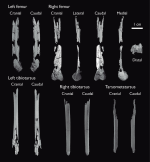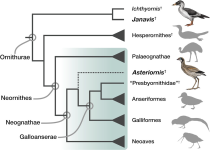albertonykus
Well-known member
Field, D.J., J. Benito, S. Werning, A. Chen, P.-C. Kuo, A. Crane, K.E. Widrig, D.T. Ksepka, and J.W.M. Jagt (2024)
Remarkable insights into modern bird origins from the Maastrichtian type area (north-east Belgium, south-east Netherlands)
Netherlands Journal of Geosciences 103: e15
doi: 10.1017/njg.2024.11
For centuries, fossils from the Maastrichtian type locality and adjacent quarries have provided key evidence of vertebrate diversity during the latest Cretaceous, yet until recently the Maastrichtian type area had revealed no important insights into the evolutionary history of birds, one of the world’s most conspicuous groups of extant tetrapods. With the benefit of high-resolution micro-CT scanning, two important avian fossils from the Maastrichtian type area have now been examined in detail, offering profound, complementary insights into the evolutionary history of birds. The holotype specimens of these new taxa, Janavis finalidens Benito, Kuo, Widrig, Jagt and Field, 2022, and Asteriornis maastrichtensis Field, Benito, Chen, Jagt and Ksepka, 2020, were originally collected in the late 1990s, but were only investigated in detail more than twenty years later. Collectively, Janavis and Asteriornis provide some of the best evidence worldwide regarding the factors that influenced stem bird extinction and crown bird survivorship through the Cretaceous-Palaeogene transition, as well as insights into the origins of key anatomical features of birds such as an extensively pneumatised postcranial skeleton, a kinetic palate, and a toothless beak. Asteriornis also provides scarce evidence of a Cretaceous-aged divergence time calibration within the avian crown group, while together, Janavis and Asteriornis constitute the only documented co-occurrence of crown birds and non-neornithine avialans. Here, we review key insights into avian evolutionary history provided by these discoveries from the Maastrichtian stratotype, document undescribed and newly discovered Maastrichtian fossils potentially attributable to Avialae and provide the first histological data for the holotype of Asteriornis, illustrating its skeletal maturity at the time of its death.
Remarkable insights into modern bird origins from the Maastrichtian type area (north-east Belgium, south-east Netherlands)
Netherlands Journal of Geosciences 103: e15
doi: 10.1017/njg.2024.11
For centuries, fossils from the Maastrichtian type locality and adjacent quarries have provided key evidence of vertebrate diversity during the latest Cretaceous, yet until recently the Maastrichtian type area had revealed no important insights into the evolutionary history of birds, one of the world’s most conspicuous groups of extant tetrapods. With the benefit of high-resolution micro-CT scanning, two important avian fossils from the Maastrichtian type area have now been examined in detail, offering profound, complementary insights into the evolutionary history of birds. The holotype specimens of these new taxa, Janavis finalidens Benito, Kuo, Widrig, Jagt and Field, 2022, and Asteriornis maastrichtensis Field, Benito, Chen, Jagt and Ksepka, 2020, were originally collected in the late 1990s, but were only investigated in detail more than twenty years later. Collectively, Janavis and Asteriornis provide some of the best evidence worldwide regarding the factors that influenced stem bird extinction and crown bird survivorship through the Cretaceous-Palaeogene transition, as well as insights into the origins of key anatomical features of birds such as an extensively pneumatised postcranial skeleton, a kinetic palate, and a toothless beak. Asteriornis also provides scarce evidence of a Cretaceous-aged divergence time calibration within the avian crown group, while together, Janavis and Asteriornis constitute the only documented co-occurrence of crown birds and non-neornithine avialans. Here, we review key insights into avian evolutionary history provided by these discoveries from the Maastrichtian stratotype, document undescribed and newly discovered Maastrichtian fossils potentially attributable to Avialae and provide the first histological data for the holotype of Asteriornis, illustrating its skeletal maturity at the time of its death.





